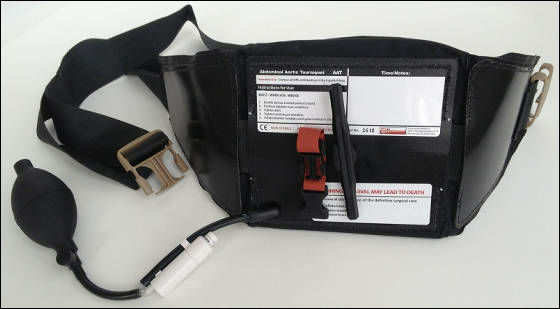The state-of-the-art tourniquet 'Abdominal Aortic Tourniquet' that the U.S. military is proud of

'Game changer:' Tourniquet for abdominal wounds is already saving lives | Texas OnSite CPR
https://www.texasonsitecpr.com/resources/first-aid-news/game-changer-tourniquet-for.html
◆ Abdominal Aortic Tourniquet
Until very recently, there was no way to stop bleeding in the area below the torso, unlike the arms and legs that can use a hemostatic squeezer. For this reason, if the torso is injured and bleeds, it will die within a few minutes, and how to deal with bleeding in areas where hemostasis cannot be used on the battlefield has been a major issue.
Veterans surgeons John Cruchon and Richard Schwartz devised a pump-type hemostatic device that tightens the abdomen of a soldier injured in battle to stop bleeding after completing a mission in Iraq. This was a new type of hemostatic device that pumped air to apply a pressure of about 80 pounds (about 36 hPa) to the abdominal aorta and deformed to block blood flow to the pelvis. After that, Ted Westmoreland, a former doctor with special military mission experience, devised a winch to prevent the hemostatic device from slipping, and further improvements were made, and the completed hemostatic device was ' Abdominal Aortic Tourniquet (Abdominal Aortic Tourniquet) It was named 'AAT)'.
Here is a photo of AAT. Use it by wrapping it around your waist like a belt.

With a little practice, AAT can be easily treated by non-doctor soldiers and is so easy to use that it can be taken out of the bag and put on in just 60 seconds. AAT applied for a patent in 2007 (currently under examination), and in 2011, it was

◆ Actual battle deployment
The AAT was first used in combat in April, saving the lives of soldiers serving in Afghanistan. The soldier with almost amputated legs was already unconscious and in cardiopulmonary arrest when he was put on the emergency helicopter, but he recovered his breathing when AAT was attached, and his heart rate was stable when he was taken to the hospital. That is.
A photo of a soldier doing hemostasis at AAT. (Click to remove the blur).

◆ Unexpected hemostatic ability
AAT has been found to have unexpected functions, such as improving blood oxygen carrying capacity, but it turns out to be even more surprisingly hemostatic.
This summer, a male patient who had a large amount of bleeding due to a bullet penetrating his upper arm was brought to the emergency room where Dr. Crucion of Birmingham works. The bullet also penetrated under the armpit, damaging one of the thickest arteries in the human body. The wound was so fatal that all patients who had previously treated similar wounds were killed because the wound could not be stopped, but Dr. Crucion calmed the panicked nurse and made the man's. When the abdomen was stopped with AAT, the bleeding stopped and the man died.
At this moment, Dr. Crucion realizes that AAT can handle not only hemostasis in the area below the torso but also massive bleeding in the upper body . Dr. Cruzion immediately shipped the latest version of AAT to the battlefield in Afghanistan.
AAT is expected to play an active role not only on the battlefield but also in general medical practice in the future. Hopefully, good medical devices will be used in life-saving settings rather than competing for lives.
Related Posts:
in Hardware, Posted by darkhorse_log







